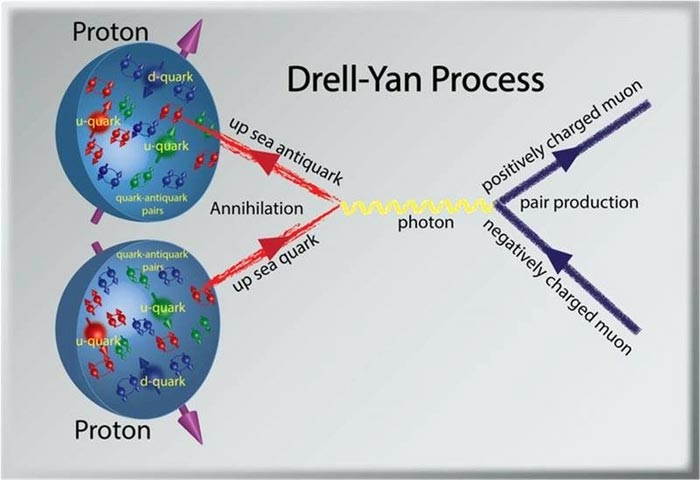Investigating an antimatter imbalance in the proton

A proton contains 3 more quarks than antiquarks (large dots) & a sea containing an equal number of quarks & of antiquarks (small dots). When two protons collide, a quark & antiquark may annihilate to create a single photon that decays to a pair of muons.
Image courtesy of Argonne National Laboratory
Scientists studied antimatter in the proton with higher precision than ever before, revealing insights into the particle’s puzzling dynamics.
The Science
The proton is a positively charged particle that exists at the center of every atom. It is a confined complex system of strongly interacting fundamental particles, quarks, and the nuclear force carriers, gluons. Its properties like charge are dominated by an excess of three quarks — two “up” quarks and one “down” quark, called valence quarks. However, take a closer look, and the proton “sea” becomes a turbulent and enigmatic mix of quarks and their antimatter counterparts, antiquarks, that pop in and out of existence before quickly annihilating each other. Scientists call these quarks the sea quarks. The SeaQuest Collaboration studied the antimatter makeup of the proton sea for a wide range of quark momenta with higher precision than ever before. They found that protons have, on average, 1.4 down antiquarks for every up antiquark.
The Impact
Protons, subatomic particles with a positive charge, are present in every atom. Understanding the structure of the proton can provide insight into the forces that hold protons together. These insights help physicists answer some of the most fundamental questions in all of science. The SeaQuest data agree with two of the many competing models of the proton, demonstrating the importance of the proton’s sea quarks. The SeaQuest findings also will help scientists parse through data from particle collisions at the Large Hadron Collider in search of new physics.
Summary
Scientists with the SeaQuest research group, a national laboratory-university joint effort, investigated an asymmetry between the up and down flavors of antiquarks in the proton sea. Their data show that in the proton, down antiquarks outnumber up antiquarks over a wide range of quark momenta. To probe the quarks and antiquarks in the proton, the scientists shot high-energy beams of protons at targets of liquid hydrogen and deuterium. They studied the aftermath of collisions between protons from the beam and nuclei in the targets. When protons collide, many things can happen. In one process, called the Drell-Yan process, the quarks and antiquarks in the colliding protons annihilate, and two new fundamental particles called muons come out of the annihilation, acting as the interaction’s signature. By studying the signatures from the collisions, the scientists determined that down antiquarks are about 40 percent more abundant in the proton than up antiquarks, even in the rare case that a single antiquark carries more than a third of the proton’s total momentum. The origin of antimatter within the proton and the observed asymmetry can be explained by models in which some of the antiquarks are carried within a cloud of virtual particles forming a field around the proton. This class of models make additional predictions about the spin of the antimatter in the proton that can be tested with future measurements.
Funding
This work was performed by the SeaQuest Collaboration, whose work was supported in part by the Department of Energy; the National Science Foundation at Mississippi State University; the JSPS (Japan) KAKENHI Tokyo Tech Global COE Program, Japan; Yamada Science Foundation of Japan; and the Ministry of Science and Technology, Taiwan.
Journal: Nature DOI: 10.1038/s41586-021-03282-z Method of Research: Experimental study Subject of Research: Not applicable Article Title: The asymmetry of antimatter in the proton Article Publication Date: 24-Feb-2021
Media Contact
Michael Church
DOE/US Department of Energy
michael.church@science.doe.gov
Office: 2028416299
All latest news from the category: Physics and Astronomy
This area deals with the fundamental laws and building blocks of nature and how they interact, the properties and the behavior of matter, and research into space and time and their structures.
innovations-report provides in-depth reports and articles on subjects such as astrophysics, laser technologies, nuclear, quantum, particle and solid-state physics, nanotechnologies, planetary research and findings (Mars, Venus) and developments related to the Hubble Telescope.
Newest articles

Innovative 3D printed scaffolds offer new hope for bone healing
Researchers at the Institute for Bioengineering of Catalonia have developed novel 3D printed PLA-CaP scaffolds that promote blood vessel formation, ensuring better healing and regeneration of bone tissue. Bone is…

The surprising role of gut infection in Alzheimer’s disease
ASU- and Banner Alzheimer’s Institute-led study implicates link between a common virus and the disease, which travels from the gut to the brain and may be a target for antiviral…

Molecular gardening: New enzymes discovered for protein modification pruning
How deubiquitinases USP53 and USP54 cleave long polyubiquitin chains and how the former is linked to liver disease in children. Deubiquitinases (DUBs) are enzymes used by cells to trim protein…


